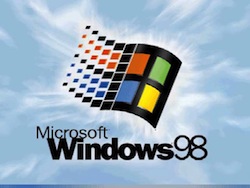Archive for May, 2014
2D Scrolling and EGA Support
May 29, 2014Originally, I was using a Matrox Millennium PCI graphics card in my DOS gaming box, but I found the 2D scrolling performance to be somewhat lacking as games like The Lost Vikings would shear while playing. The card also has virtually no EGA graphics mode support, which was important to me since I wanted to run games like Crystal Caves from Apogee, and I also wanted the development option of writing computer graphics programs written for this video mode.
Enter the S3 ViRGE (Virtual Reality Graphics Engine).
Interestingly, this was S3’s first attempt at a 3D graphics accelerator card. The performance was somewhat lower than expected, however, making the card only slightly faster than the best software renderers at the time, and equal to those renderers when anything other than the simplest 3D techniques were used. Because of the card’s poor performance, it was dubbed the “Worlds First Graphics Decelerator” by critics in the graphics and gaming communities.
I own the “DX” model of this card which is somewhat more performant than its predecessor, but I didn’t buy the card for how well it could render 3D graphics so it matters very little to me. I bought the card for how well it could accelerate 2D graphics and its support for lower end video modes, and it is very impressive thus far.
Categories: DOS, Game Development, Games, Graphics, Hardware, PC, Retro
No Comments »
I wrote a little space invaders game in SVG (Scalable Vector Graphics) several years ago. It plays sound effects and has a few of the essential features within the game. I have recently modified it to work on Google Chrome browsers, since it was originally built to run within Adobe’s SVG Viewer plug-in which could only run on Windows 98 or XP platforms.
It’s a great game for people who are new to programming to get their feet wet and hack around with it. Some of the core concepts needed to modify the game to any great extent would be a rudumentary knowledge of JavaScript, SVG, and DOM level programming; you can run the game in the browser directly, there is no need to embed it within an HTML page although that is certainly possible, and you also download it here. You can move the player using the ‘A’ and ‘D’ keys, and fire with the ‘S’ key. The space bar pauses and unpauses the game.
Here is a little excerpt taken from the Space Invaders Atari 2600 manual:
Welcome to Space Invaders! Before you can begin playing, the first step is to place your cursor over the docking rectangle in the upper-left hand corner. Once the cursor has been positioned over the rectangle, click it and it should change color. Lift your hand from the mouse and you’re ready to play!
You are a recent enlistee in the Earth Defense Corps. For the past six weeks you’ve undergone grueling and intensive training. Now you stand at attention, nervously anticipating the most critical section of your training…
“Okay, kid, you’re on!” barks your commanding officer.
Quickly you climb into a laser tank. A second enlistee follows you. You each settle into deep, leather seats. With a soft whirring sound, the automatic hatch cover closes overhead. As your eyes adjust to the dim light of the laser capsule, you begin to make out the controls. Mentally, you check off each knob, dial, button, and display. For the next several hours you and the other enlistee with operate these controls to defend your planet in an attack simulation. The screen in front of you lights up. A column of bomb-dropping aliens advances toward you. What next? For a second your mind goes blank. Have you learned your lessons well? No time to refer to the manual now. Your commanding officers are watching and it’s your show.
Your tasks are to stop the invaders from landing on your territory; avoid enemy bombs; and score as many points as possible. The simulation ends when you lose all your lives or when any invader lands on your planet. If you destroy all 36 space invaders before they touch your planet, a new set of invaders will appear on the screen. Each new set of invaders will move a little faster than the previous set.
You begin each game with three shields. Initially, you are safe behind the shields. But as you and the enemy hit the shields with lasers and bombs, they become damaged and eventually disappear altogether. As the space invaders come close to the shields in their descent toward you, the shields will be destroyed and your only hope is to destroy the remaining invaders before it’s too late…
Categories: Games, Programming, Retro
No Comments »
Child of Light
May 22, 2014My wife is having a great time playing the Ubisoft game called Child of Light. It looks absolutely gorgeous with an interesting narrative and character model, great music, and a fluid control system. I am definitely looking forward to playing it!
Categories: Games, Windows
No Comments »
Windows 98 Game Machine
May 12, 2014 I have been wanting to build a Windows 98 retrobox machine for a long time, since running Windows 98 games in a virtual machine with hardware acceleration that works is next to impossible, and although I know of and have downloaded games from services like Steam and gog.com, they don’t solve the problem of how to install other Windows 98 software that I am interested in using. I also enjoy the visual nuances produced by 3DFX chipsets and drivers which are not emulated by either service.
I have been wanting to build a Windows 98 retrobox machine for a long time, since running Windows 98 games in a virtual machine with hardware acceleration that works is next to impossible, and although I know of and have downloaded games from services like Steam and gog.com, they don’t solve the problem of how to install other Windows 98 software that I am interested in using. I also enjoy the visual nuances produced by 3DFX chipsets and drivers which are not emulated by either service.
The trick is in selecting the right hardware for maximum compatibility and performance. As a starting point, I have chosen the following pieces of hardware to assemble a basic machine:
- Asus P4B Motherboard with 512 MB of RAM
- SoundBlaster 128 PCI
- Radeon 9600 Pro PCI with 128 MB of VRAM
- DFE 538-TX PCI Network Card
- SD Card to IDE Interface Board
The last item may need a bit of explaining. Basically, I don’t want to deal in hard drives anymore; I want a technology which I can use to easily backup and recover software images for some of the older machines I maintain. I also want something a little less noisy and faster than a typical hard drive used the in early 2000-2006 period for Windows 98 installations. After some research, I have ordered a unit or two off of eBay a few weeks ago for just a few dollars. I want to use just one or two to trial the hardware, since I have never used these boards before and I don’t know what their limitations are. I have been using the board now for a few weeks and it seems to be performing nicely. I really enjoy the ability to remove the “drive”, shove it into an SD card reader, add a few files which would have been otherwise tedious to download via the platform’s ancient Firefox installation (I am using the latest for the Window 98SE platform, which is version 2.0.12 I think).
A warning around RAM and Windows 98SE installations. I began this process with 1 GB of RAM and throughout the process of getting my benchmark games up and running and the platform driver installations ironed out, I was plagued by mysterious problems like random crashes, screen freezing, DirectX audio issues, and out of memory errors. The out of memory errors happened less frequently, unfortunately, which made debugging the issue rather difficult, since it appeared that my sound card drivers were the source of the problems and not the onboard memory. In the end, it was due to the amount of memory I had installed on that motherboard several months ago. Once I removed the “extra” 512 MB of RAM, things just started working flawlessly. I have done a bit of research and it seems that certain hardware and software problems within the OS can trigger these issues, but it is still possible to enjoy 1 GB of memory on some installations and OS configurations, even though the operating system may not use it. In general, if you have a Window ME installation available, then use that as it seems to be a more robust Windows 98 era platform.
The games I have tested so far are Deus Ex and System Shock 2; there are issues surrounding the latter within my new installation, which I will get into in a later post.
Categories: Games, Retro, Software, Windows
No Comments »







